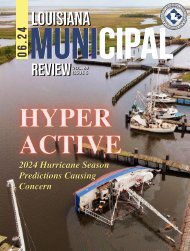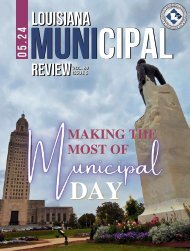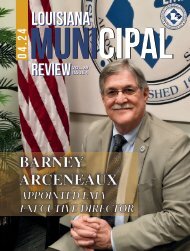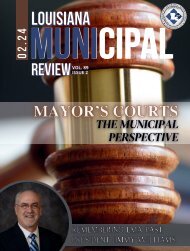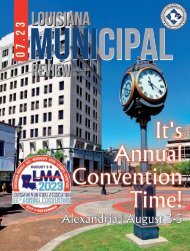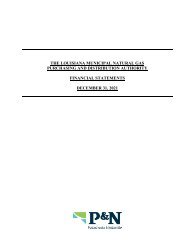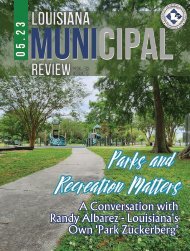GOHSEP Elected_Officials_Manual_2015
You also want an ePaper? Increase the reach of your titles
YUMPU automatically turns print PDFs into web optimized ePapers that Google loves.
What you need to know about DEBRIS OPERATIONS. NOW!<br />
Purpose of this document: To provide summary guidance on debris management monitoring and operations. You are responsible for following<br />
all local + state + federal regulations.<br />
PRE-DISASTER RESPONSE RECOVERY<br />
<strong>GOHSEP</strong> Debris Operations guidance<br />
BEST PRACTICES PRE-DISASTER*<br />
BASIC DEBRIS MANAGEMENT CHECKLIST<br />
Develop a debris management plan.<br />
A better practice is to develop a FEMA-approved<br />
management plan.<br />
Identify a Louisiana Department of Environmental<br />
Quality (LDEQ) permitted debris management site.<br />
Prequalify your debris monitoring contractors +<br />
maintain list.<br />
Prequalify debris contractors + maintain list.<br />
Develop an RFP template for debris removal +<br />
monitoring contracts.<br />
Establish collection priorities.<br />
*The above represent Best Practices to assist in assuring<br />
that applicants maximize the funds they are eligible to<br />
receive and retain those funds through the reimbursement<br />
and audit processes.<br />
Establish debris operation priorities to eliminate<br />
immediate threat to lives and public property.<br />
Consider using in-house force account labor prior<br />
to awarding debris contract(s). Applicant is<br />
responsible for up to 25% of contract costs.<br />
Monitor all debris removal closely. Your debris<br />
monitoring contractor should provide qualified<br />
and trained field monitors.<br />
Useful FEMA debris-related references.<br />
Ensure use of load tickets for both force account<br />
labor + contracted debris operations.<br />
Time + material costs are limited to work<br />
Ensure debris operations are restricted to<br />
performed during the first 70 hours of actual work event-related debris.<br />
DISASTER ASSISTANCE POLICIES<br />
following a disaster.<br />
Ensure debris operations are restricted to<br />
• After 70 hours, contracts should be • unit 9523.4 price Demolition property + right of Private of ways that Structures are the (7.18.07) http://www.fema.gov/pdf/government/grant/pa/9523_4.pdf<br />
(strongly recommended) or lump sum.<br />
responsibility of the applicant.<br />
• 9523.5 Debris Removal from Waterways (3.29.10) http://www.fema.gov/pdf/government/grant/pa/9523_5.pdf<br />
Use RFPs for ALL WORK other than first 70 hours.<br />
Encourage citizens to separate debris brought to<br />
Use fair + open competitive procurement • process. 9523.11 Hazardous the curb (e.g., Stump vegetative Extraction debris, white goods, and Removal Eligibility (5.25.07) http://www.fema.gov/pdf/government/grant/<br />
Assure that all work is reflected in the PW scope of tires, etc.).<br />
work.<br />
pa/9523_11.pdf Ensure monitoring contractor conducts daily<br />
The RFP + contract SOW should be consistent • 9523.12 with Debris reconciliation Operations of all debris — operations Hand-Loaded Trucks and Trailers (8.17.10) http://www.fema.gov/pdf/government/grant/<br />
the PW SOW. Differences may cause<br />
documentation (e.g., load tickets, pictures,<br />
reimbursement delays.<br />
pa/9523_12.pdf vehicle certifications, etc.).<br />
Cubic yards recommended as unit of<br />
DOCUMENT, DOCUMENT, DOCUMENT!<br />
• 9523.13 Debris Removal from Private Property (7.18.07) http://www.fema.gov/pdf/government/grant/pa/9523_13.pdf<br />
measurement for most debris.<br />
Award contract to most responsive bidder based<br />
on your established criteria.<br />
FEMA JOB AIDS + FACT SHEETS<br />
All contracts are subject to cost reasonableness<br />
analysis [44 CFR 13.36(f)]. • 9580.4 Fact Sheet: Emergency Work Contracting (10.23.08) http://www.fema.gov/pdf/government/grant/pa/9580_4.pdf<br />
Monitoring contract must provide for reporting<br />
• 9580.201 Fact Sheet: Debris Contracting Guidance (9.27.10) http://www.fema.gov/pdf/government/grant/pa/9580_201.pdf<br />
requirements that demonstrate eligible work.<br />
Recommend FEMA approve monitoring - Attachment 1: Debris Removal Contract Cost Analysis http://www.fema.gov/pdf/government/grant/pa/9580_201_<br />
requirements to demonstrate eligible work.<br />
attachment1.pdf<br />
Coordinate with LDEQ for all debris disposal<br />
permitting requirements.<br />
- Attachment 2: Debris Operations Contract Bid Sheet http://www.fema.gov/pdf/government/grant/pa/9580_201_<br />
DOCUMENT, DOCUMENT, DOCUMENT!<br />
attachment2.pdf See <strong>GOHSEP</strong> Procurement Guide for additional assistance.<br />
9-7-12<br />
• 9580.203 Fact Sheet: Debris Monitoring (5.03.07) http://www.fema.gov/pdf/government/grant/pa/9580_203.pdf<br />
• 9580.204 Fact Sheet: Documenting and Validating Hazardous Trees, Limbs and Stumps (8.02.09) http://www.fema.<br />
NOTE: Only FEMA-eligible and reasonable debris costs will be reimbursed.<br />
ONLY FEMA gov/pdf/government/grant/pa/9580_204.pdf<br />
DECIDES WHAT IS ELIGIBLE and REASONABLE.<br />
FEMA GUIDANCE DOCUMENTS<br />
• FEMA 325: Public Assistance Debris Management Guide (July 2007) http://www.fema.gov/pdf/government/grant/pa/<br />
demagde.pdf<br />
• FEMA 327: Public Assistance Debris Monitoring Guide (October 2010) http://www.fema.gov/pdf/government/grant/pa/<br />
fema_327_debris_monitoring.pdf<br />
• FEMA 329: Debris Estimating Field Guide (September 2010) http://www.fema.gov/pdf/government/grant/pa/fema_329_<br />
debris_estimating.pdf<br />
• 44 CFR 13.36: http://www.gpo.gov/fdsys/pkg/CFR-2011-title44-vol1/pdf/CFR-2011-title44-vol1-sec13-36.pdf<br />
LOUISIANA DEPARTMENT OF ENVIRONMENTAL QUALITY<br />
• LDEQ: http://www.deq.louisiana.gov<br />
This public document is published by the Governor’s Office of Homeland Security and Emergency Preparedness (<strong>GOHSEP</strong>), State of Louisiana. 1100 copies of this public document were published in this 2nd<br />
printing at a cost of $2,815.37. The total cost of all printings of this document, including reprints is $3,814.33. This document was published for the purpose of providing public information and education. This<br />
material was printed in accordance with standards for printing by state agencies established pursuant to R.S. 43:31. Printing of this material was purchased in accordance with the provisions of Title 43 of the<br />
Louisiana Revised Statues.<br />
• Developing a Request for Proposal (RFP)<br />
template for the solicitation of debris removal<br />
and monitoring contracts.<br />
CONTRACTING<br />
FEMA provides a Debris Removal Applicant’s Contracting<br />
Checklist (Recovery Policy [RP] 9580.201) to assist<br />
Applicants in the procurement process in selecting a<br />
debris contractor. The checklist can be downloaded<br />
at fema.gov/public-assistance-9500-series-policypublications/debris-removal-applicant%27scontracting-checklist.<br />
It is important to know that time and material costs are<br />
limited to work performed during the first 70 hours<br />
of actual work following a disaster. After 70 hours,<br />
contracts should be unit price or lump sum — unit<br />
price is strongly advised.<br />
Best practices<br />
Best practices in contracting suggest maintaining an<br />
independent relationship between debris contract<br />
monitor(s) and the debris removal contractor.<br />
You should also consider assigning someone from<br />
your staff to be your Debris Manager. Part of his/her<br />
role is to provide oversight to debris contractors – both<br />
contracted monitors and debris removal contractors.<br />
5.3 Debris Removal Page 2 of 4



